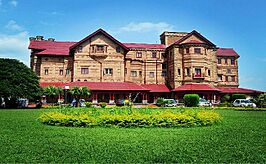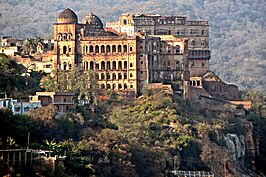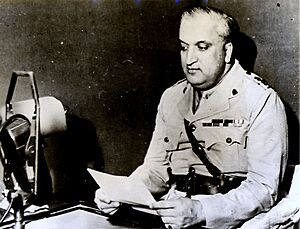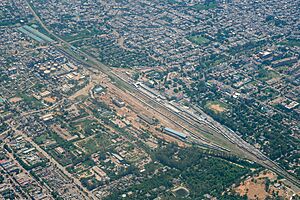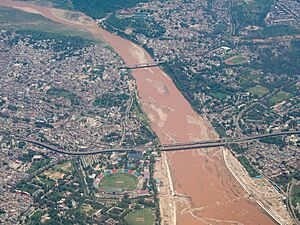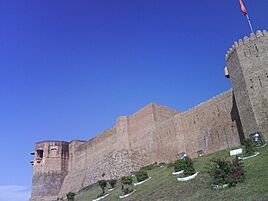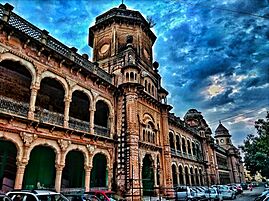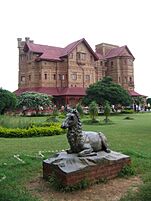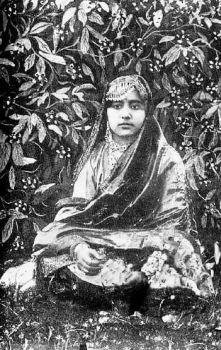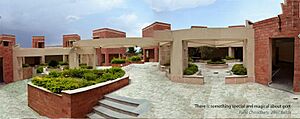Jammu facts for kids
Quick facts for kids
Jammu
|
|
|---|---|
|
City
|
|
|
Hari Niwas Palace, Bahu Fort, Tawi Bridge and Mubarak Mandi Palace
|
|
| Nickname(s):
City of Temples
|
|
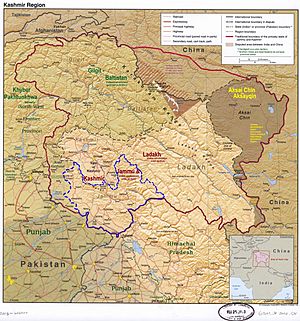
Jammu lies in the Jammu division (neon blue) of the Indian-administered Jammu and Kashmir (shaded tan) in the disputed Kashmir region.
|
|
| Administering country | India |
| Region of administration | Union territory of Jammu and Kashmir |
| District | Jammu |
| Government | |
| • Type | Municipal Corporation |
| • Body | Jammu Municipal Corporation and Jammu Development Authority |
| Area | |
| • City | 240 km2 (90 sq mi) |
| Elevation | 300–400 m (1,000-1,300 ft) |
| Population
(2011)
|
|
| • City | 502,197 |
| • Rank | 94th |
| • Density | 45/km2 (120/sq mi) |
| • Metro | 657,314 |
| Demonym(s) | Jammuwala, Jammuwale, Jammuites |
| Language | |
| • Official | Hindi, Dogri, Urdu, Kashmiri, English |
| • Other | Punjabi |
| Time zone | UTC+5:30 (IST) |
| PIN |
180001
|
| Vehicle registration | JK-02 |
| Sex ratio | 867 ♀/ 1000 ♂ |
| Literacy | 90.14% |
| Distance from Delhi | 575 km (357 mi) NW |
| Distance from Mumbai | 1,971 km (1,225 mi) NE (land) |
| Climate | Cwa (Köppen) |
| Precipitation | 710 mm (28 in) |
| Avg. summer temperature | 29.6 °C (85.3 °F) |
| Avg. winter temperature | 17.7 °C (63.9 °F) |
Jammu is a city in India. It is part of Jammu and Kashmir, a region that India manages. Jammu is the winter capital of this union territory. It is also the main city and headquarters of the Jammu district.
The city sits on the banks of the Tawi River. It covers an area of 240 km2 (93 sq mi). To the north, it is surrounded by the Himalayas. The flat northern plains are to its south. Jammu is the second-largest city in the union territory. It is often called the "City of Temples" because of its many old temples and Hindu holy places.
Contents
- What's in a Name? The Story of Jammu
- Jammu's Location and Landscape
- A Look Back: Jammu's History
- Jammu's Weather
- Getting Around: Transport in Jammu
- How Jammu is Governed
- Jammu's Economy
- Exploring Jammu: Tourism
- People of Jammu: Demographics
- Learning in Jammu: Education
- Tasty Treats: Jammu's Cuisine
- New Residents: Refugees in Jammu
- Images for kids
- See also
What's in a Name? The Story of Jammu
Local stories say that Jammu got its name from its founder, Raja Jambulochan. People believe he ruled this area in the 9th century. Some traditions suggest the city is 3000 years old. However, historians do not have proof to support this idea.
Jammu's Location and Landscape
Jammu is located at 32°44′N 74°52′E / 32.73°N 74.87°E. It is about 300 m (980 ft) (1000 feet) above sea level. The city is built on hilly land with low ridges. These hills are part of the Shivalik hills.
The Shivalik range surrounds Jammu to the north, east, and southeast. The Trikuta Range is to the northwest. Jammu is about 600 kilometres (370 mi) from New Delhi, India's capital.
The Tawi River flows through the city. The older part of Jammu is on the north side of the river. Newer areas have grown on the south side. There are five bridges that cross the Tawi River in Jammu.
A Look Back: Jammu's History
Writings from Tarikh-i-Azmi suggest that Jammu started around 900 CE. A state called Durgara (which means "Duggar" or "Dogra" today) also existed around this time. Its capital was likely Vallapura, now known as Billawar. Rulers from this area are mentioned in Kalhana's Rajatarangini, an old historical book.
Jammu is mentioned in the records of Timur, a famous ruler who visited Delhi in 1398. He passed through Jammu on his way back to Samarkand. Later, in the early 1500s, Babur's writings describe Jammu as a strong state in the Punjab hills. It was ruled by Manhas Rajputs.
Jammu in Modern Times

After the Mughal Empire became weaker in the 1700s, Jammu became very powerful. This was under Raja Ranjit Dev (1728–1780). He was known for allowing religious freedom. This attracted many skilled workers and traders to Jammu. This helped the city's economy grow.
Later, Sikh groups from Punjab took control of the area. In 1808, Ranjit Singh added Jammu to his Sikh Empire.
In 1818, Raja Kishore Singh became the ruler of Jammu. His family, the Dogra dynasty, later ruled the large princely state of Jammu and Kashmir under British rule. These rulers built many temples, schools, and renovated old shrines. A railway line connecting Jammu to Sialkot was built in 1897.
Jammu has always been important. It was the capital of Jammu Province. It was also the winter capital of the princely state of Jammu and Kashmir from 1846 to 1952. After India was divided in 1947, Jammu continued to be the winter capital of the Indian state of Jammu and Kashmir.
Jammu's Weather
Jammu has a humid subtropical climate. This means it has very hot summers and cool winters. In summer, temperatures can reach 46 °C (115 °F). In winter, they can drop below 4 °C (39 °F).
June is usually the hottest month, with average highs around 40.6 °C (105.1 °F). January is the coldest, with average lows around 7 °C (45 °F). Jammu gets about 1,400 mm (55 in) of rain each year. Most of this rain falls during the monsoon season, from June to September. Winters can also be quite wet.
During winter, thick fog can cause problems. In summer, especially in May and June, strong sunlight or hot winds can make temperatures rise very high. After the hot season, the monsoon brings heavy rain and thunderstorms.
| Climate data for Jammu (1991–2020, extremes 1925–2020) | |||||||||||||
|---|---|---|---|---|---|---|---|---|---|---|---|---|---|
| Month | Jan | Feb | Mar | Apr | May | Jun | Jul | Aug | Sep | Oct | Nov | Dec | Year |
| Record high °C (°F) | 28.0 (82.4) |
31.7 (89.1) |
37.3 (99.1) |
43.9 (111.0) |
47.4 (117.3) |
47.2 (117.0) |
45.0 (113.0) |
41.7 (107.1) |
39.2 (102.6) |
37.9 (100.2) |
34.2 (93.6) |
28.5 (83.3) |
47.4 (117.3) |
| Mean daily maximum °C (°F) | 18.1 (64.6) |
21.5 (70.7) |
26.6 (79.9) |
32.7 (90.9) |
37.6 (99.7) |
38.3 (100.9) |
34.3 (93.7) |
33.1 (91.6) |
32.8 (91.0) |
31.1 (88.0) |
26.4 (79.5) |
21.1 (70.0) |
29.5 (85.0) |
| Mean daily minimum °C (°F) | 7.3 (45.1) |
10.2 (50.4) |
14.5 (58.1) |
19.7 (67.5) |
24.3 (75.7) |
26.1 (79.0) |
25.5 (77.9) |
24.9 (76.8) |
23.2 (73.8) |
18.4 (65.1) |
13.0 (55.4) |
8.7 (47.7) |
18.0 (64.4) |
| Record low °C (°F) | 0.5 (32.9) |
1.1 (34.0) |
4.4 (39.9) |
8.5 (47.3) |
9.8 (49.6) |
13.8 (56.8) |
14.0 (57.2) |
15.0 (59.0) |
15.0 (59.0) |
11.3 (52.3) |
6.1 (43.0) |
0.9 (33.6) |
0.5 (32.9) |
| Average precipitation mm (inches) | 67.9 (2.67) |
74.6 (2.94) |
64.1 (2.52) |
41.4 (1.63) |
22.5 (0.89) |
109.5 (4.31) |
416.5 (16.40) |
403.1 (15.87) |
144.8 (5.70) |
23.5 (0.93) |
12.2 (0.48) |
21.9 (0.86) |
1,402 (55.2) |
| Average precipitation days (≥ 0.3 mm) | 5.3 | 6.8 | 6.6 | 5.6 | 5.5 | 8.7 | 17 | 16.7 | 8.4 | 2.7 | 1.9 | 2.5 | 87.7 |
| Average relative humidity (%) | 76 | 68 | 60 | 45 | 38 | 49 | 73 | 78 | 74 | 64 | 68 | 75 | 64 |
| Source: NCEI | |||||||||||||
Getting Around: Transport in Jammu
Jammu has a railway station called Jammu Tawi (JAT). It connects Jammu to many big cities in India. An older railway line to Sialkot was closed in 1947. Jammu did not have train services again until 1971. That's when the Indian Railways built a new line.
The new Jammu Tawi station opened in October 1972. It is a starting point for many express trains. Soon, all trains going to the Kashmir Valley will pass through Jammu Tawi. Part of this project is already done, extending the track to Katra.
National Highway 44 goes through Jammu. It connects the city to the Kashmir valley. Another road, National Highway 1B, links Jammu with Poonch town. Jammu is 80 kilometres (50 mi) from Kathua and 68 kilometres (42 mi) from Udhampur. The famous pilgrimage town of Katra is 49 kilometres (30 mi) away.
Jammu Airport is located in the city. It has direct flights to cities like Srinagar, Delhi, Mumbai, and Bengaluru. Many airlines operate flights from Jammu Airport daily.
For local travel, Jammu has city buses and minibusses called "Matadors." You can also find auto-rickshaws, cycle-rickshaws, and local taxis.
How Jammu is Governed
Jammu city serves as the winter capital of Jammu and Kashmir. From November to April, all government offices move from Srinagar to Jammu. Srinagar is the summer capital from May to October. Jammu became a municipal corporation in 2003, which means it has its own local government.
Jammu's Economy
Jammu city is a major center for culture and business in its region. A special kind of basmati rice is grown nearby in the RS Pura area. This rice is then processed in mills in Jammu. The industrial area at Bari Brahamna has many factories. They make various products, including carpets and electronic goods.
Exploring Jammu: Tourism
Tourism is a very important industry for Jammu. It is also a key stop for people traveling to Vaishno Devi and the Kashmir valley. This is because it is one of the last railway stops in North India. All roads leading to Kashmir, Poonch, Doda, and Laddakh start from Jammu. So, the city is busy with visitors from all over India throughout the year.
Some interesting places to visit include:
- Old historic palaces like Mubarak Mandi Palace and Amar Mahal.
- Bahu Fort, a historic fort.
- Important temples like Raghunath Temple and Ranbireshwar Temple.
- Other sites like Purani Mandi, Rani Park, Karbala, and Peer Meetha.
People of Jammu: Demographics
In 2011, Jammu city had a population of 502,197 people. About 52.7% were males and 47.3% were females. For every 1,000 males, there were 898 females. This is lower than the national average of 940.
Jammu has a high literacy rate of 89.66%. This is much higher than India's average of 74.4%. About 8.47% of the population was under 6 years old. The larger urban area of Jammu had a population of 657,314. Most Hindus in Jammu and Kashmir live in the Jammu region. Many of them speak the Dogri language.
| Rank | Language | 1961 |
|---|---|---|
| 1 | Dogri | 55% |
| 2 | Punjabi | 22% |
| 3 | Hindi | 11.6% |
| — | Other | 11.4% |
Communities in Jammu
Before India was divided in 1947, Jammu city had a notable Muslim population. After 1947, many Muslims moved to Pakistan. Many prominent people in Pakistan, like politician Chaudhry Amir Hussain and singer Malika Pukhraj, were originally from Jammu. Over time, many of these displaced people returned and settled back in the area.
Learning in Jammu: Education
In 2014–2015, the Indian government suggested building an Indian Institute of Technology and an Indian Institute of Management in Jammu. Here are some of the educational institutions in the city:
Engineering Colleges
- Indian Institute of Technology Jammu
- Government College of Engineering and Technology, Jammu
- Model Institute of Engineering and Technology, Jammu
- Yogananda College of Engineering and Technology, Jammu
- University Institute of Engineering and Technology, University of Jammu
Medical Institutions
- Indian Institute of Integrative Medicine, CSIR
- Government Medical College, Jammu
Law Colleges
- Kishen Chand Law College, Jammu
- Dogra Law College, Jammu
- Calliope School of Legal Studies, Jammu
- R. K. Law College, Jammu
General Degree Colleges
- Govt. Gandhi Memorial Science College, Jammu
- Govt. MAM PG College, Jammu
Universities
- Central University of Jammu
- Sher-e-Kashmir University of Agricultural Sciences and Technology of Jammu
- University of Jammu
Schools
- Kendriya Vidyalaya, Bantalab
- Kendriya Vidyalaya, Sunjuwan
Tasty Treats: Jammu's Cuisine
Jammu is famous for its delicious foods. These include sund panjeeri, patisa, and rajma with rice. Another special item is Kalari cheese.
Dogri food specialties include:
- Ambal
- Khatta meat
- Kulthein di dal
- Dal patt
- Maa da madra
- Rajma
- Auriya
Pickles from Jammu are made from various ingredients. These include kasrod, girgle, mango with saunf, jimikand, tyaoo, seyoo, and potatoes. Auriya is a dish made with potatoes.
Jammu cuisine also features many types of chaat. Popular choices are gol gappas, kachalu, Chole bhature, gulgule, rajma kulche, and dahi palla.
New Residents: Refugees in Jammu
Jammu city has become home to many people who have moved from other places.
Kashmiri Pandit Refugees
Many Kashmiri Hindus moved to Jammu from the Kashmir Valley starting in 1989. They sought safety in Jammu. Hindus from Pakistan-administered Jammu and Kashmir have also settled here. Records show that about 26,319 Hindu families from Pakistan-administered Jammu and Kashmir have made Jammu their home.
Rohingya Refugees
Rohingyas who left Myanmar around 2016 have also settled in Jammu.
Images for kids
See also
 In Spanish: Jammu (ciudad) para niños
In Spanish: Jammu (ciudad) para niños


